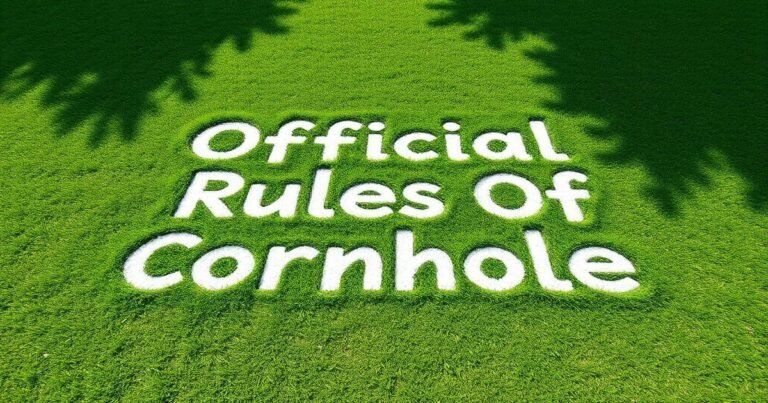Distance Between Cornhole Boards: The Official cornhole Court
A cornhole court is the designated playing area where the cornhole game takes place. It includes the cornhole boards, the pitcher’s boxes, and the foul line. The layout ensures a fair and standardized environment for players to compete, whether it’s a casual backyard game or a professional tournament.
The court must be flat and free of obstacles, providing an even playing surface for smooth gameplay. Adhering to these standards enhances the sport of cornhole and ensures consistency. Without the proper setup, the game can become unfair and less enjoyable for players

2. What are the Official Cornhole Court Dimensions?
The regulation cornhole court dimensions are 8 feet wide and 40 feet long, with the cornhole boards placed 27 feet apart from front edge to front edge. This setup is required for official games as defined by the American Cornhole Association.
For junior play, the court can be adjusted to 21 feet between boards. The pitcher’s box is located on either side of the board, ensuring players have a clear space to stand during their throws. The size of the court plays a significant role in the flow of the game, as it determines how difficult it is to land the cornhole bags in the hole.

3. Distance Between Cornhole Boards: How Far Should They Be?
In a regulation cornhole court, the distance between cornhole boards must be 27 feet apart. Below is the tabular illustration of the cornhole court dimensions.
| Metric | Value |
|---|---|
| Court Dimensions | 8 feet wide, 40 feet long |
| Distance Between Boards | 27 feet (regulation play) |
| Distance Between Boards (For Juniors) | 21 feet (junior/casual play) |
| Pitcher’s Box Area | 3 feet on both sides of the board |
| Foul Line | Front edge of each board |
| Court Spacing (Multiple Courts) | At least 10 feet apart |
| Indoor Vertical Clearance | Minimum 12 feet |
4. The Importance of the Foul Line in Cornhole
The foul line is a crucial element of the cornhole court, located at the front edge of each board.Players pitch from behind this line and keep their feet within the designated pitcher’s box during their throw. The foul line prevents any player from gaining an unfair advantage by stepping too close to the board.
Crossing the foul line results in a foul bag, which is removed from play and cannot score points. Following this rule maintains fairness and consistency in the game of cornhole. A foul bag can change the outcome of a round, so it’s essential for players to respect this rule to keep the game fair and fun.
5. How to Set Up Multiple Cornhole Courts
When hosting a tournament or event, setting up multiple cornhole courts requires careful planning. Courts should be spaced at least 10 feet apart to avoid interference between games. This spacing ensures that each court has enough room for players to move around without disturbing the others.
Having multiple courts allows for a smoother tournament flow, as more games can happen at the same time. The key is to ensure there is enough space for both players and spectators. Additionally, make sure that the courts are aligned and each one follows the official cornhole court dimensions to maintain consistency throughout the event.
6. Vertical Clearance and Indoor Cornhole Courts
For indoor games, the indoor court ceiling must provide sufficient vertical clearance to accommodate high tosses. A minimum of 12 feet is recommended to prevent bags from striking the ceiling or other obstacles. Without enough clearance, the game could be disrupted, and players may not be able to pitch their bags properly.
This setup allows players to use their full range of motion, ensuring fair play even in indoor environments. When setting up an indoor cornhole court, it’s essential to measure the ceiling height to make sure there’s enough room for the bags to travel freely. Having a proper vertical clearance ensures that the game is played as intended.
7. How to Elevate Your Game with Proper Cornhole Court Setup
A well-set-up cornhole court is essential for improving your skills and enjoying the game. Ensure the boards are level, the foul line is clearly marked, and the bags in play meet regulation standards. By practicing on a properly set-up court, players can improve their accuracy and overall gameplay.
By following the rules of cornhole and practicing on an official court, players can enhance their accuracy and prepare for competitive matches. When the court is set up according to official standards, it helps create a fair playing environment, which is key to becoming a better cornhole player.
Key Takeaways
- Cornhole Court Dimensions: Regulation courts are 8 feet wide and 40 feet long, with boards placed 27 feet apart.
- Foul Line Rules: Players must stay behind the foul line during their throw to avoid penalties.
- Multiple Courts: Space courts at least 10 feet apart for smooth tournament play.
- Indoor Play: Ensure adequate vertical clearance for high tosses.
By understanding these essentials, you can set up a proper cornhole court and enjoy the exciting sport of cornhole, whether casually or competitively.





